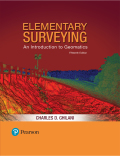
Concept explainers
In adjusting measured traverse angles‘ why aren’t adjustments made in proportion to the angle sizes?
The reason why the adjustments are not made in proportion to the angle sizes in adjusting measured traverse angles.
Answer to Problem 10.1P
Error is independent of angle size and depends on the method used for measurement.
Explanation of Solution
In elementary methods of traverse adjustment, the first step is to balance the angles to the proper geometric total. For a closed traverse angle balancing is easy since the total error is known. Angles of the closed traverse can be adjusted to the total geometry by any of the following methods:
- Applying an average correction to each angle of the traverse.
- Making larger corrections where the observations and measurements are not done properly.
In a closed traverse, if a single angle is not measured accurately then, error occurring due to one observation reflects in other observations. It is independent on the size of the angle and depends on the method used while measuring the angles. Therefore, adjustments are not made in proportion to the angle sizes in measured traverse angles.
Want to see more full solutions like this?
Chapter 10 Solutions
Elementary Surveying: An Introduction to Geomatics (15th Edition)
Additional Engineering Textbook Solutions
Starting Out with Programming Logic and Design (5th Edition) (What's New in Computer Science)
Concepts Of Programming Languages
Starting Out With Visual Basic (8th Edition)
Starting Out with Java: From Control Structures through Objects (7th Edition) (What's New in Computer Science)
Thinking Like an Engineer: An Active Learning Approach (4th Edition)
Mechanics of Materials (10th Edition)
- P.3.3 Oil of sp.gr. 0.9 flows through a vertical pipe (upwards). Two points A and B one above the other 40 cm apart in a pipe are connected by a U-tube carrying mercury. If the difference of pressure between A and B is 0.2 kg/cm², 1- Find the reading of the manometer. 2- If the oil flows through a horizontal pipe, find the reading in manometer for the same difference in pressure between A and B. Ans. 1- R= 0.12913 m, 2- R = 0.1575 m,arrow_forwardPlease solve the question by hand with a detailed explanation of the steps.arrow_forwardPlease solve the question by hand with a detailed explanation of the steps.arrow_forward
- P.3.4 A mercury U-tube manometer is used to measure the pressure drop across an orifice in pipe. If the liquid that flowing through the orifice is brine of sp.gr. 1.26 and upstream pressure is 2 psig and the downstream pressure is (10 in Hg) vacuum, find the reading of manometer. Ans. R=394 mm Hgarrow_forwardProject management questionarrow_forwardQ5/B with Explantion plsarrow_forward
- project management question Q5/Barrow_forwardProblem 1: Given: In a given floor system, a 5-in concrete slab supported by T-beams of 24-ft spans, supporting 354 psf live load. The T-beams are spaced 2x4 ft on center, and bw (width of the beam web) = 15 inches. Total T-beam height is 25 inches. f'c = 4,000psi, fy = 60,000psi. Design the T-beam. Show all steps. Sketch your Design. Problem 2: Given: A 25"x25" column is subject to a factored axial load of Pu=1,200 kips, and factored design moment of Mu-354 kips-ft. f'c 4,000psi, fy = 60,000psi. Determine the required steel ratio (p) and ties. Sketch the design. 2.0 0.08 INTERACTION DIAGRAM R4-60.9 fc-4 ksi 1.8 1,- 60 ksi 0.07 Y=0.9 16 1.6 0.06 Kmax 0.05 1.4 f/f, = 0 0.04 00 K₁ = P₁/f'c Ag 1.2 12 0.03 0.25 1.0 10 0.02 0.01 0.8 0.6 0.4 €,= 0.0035 0.2 €,= 0.0050 0.0 h yh 0.50 0.75 1.0. 0.00 0.05 0.10 0.15 0.20 0.25 0.30 0.35 0.40 0.45 0.50 R₁ = P₁e/f'Agharrow_forwardGiven: In a given floor system, a 5-in concrete slab supported by T-beams of 24-ft spans, supporting 354 psf live load. The T-beams are spaced 2x4 ft on center, and bw (width of the beam web) = 15 inches. Total T-beam height is 25 inches. f'c = 4,000psi, fy = 60,000psi. Design the T-beam. Show all steps. Sketch your Design.arrow_forward
 Architectural Drafting and Design (MindTap Course...Civil EngineeringISBN:9781285165738Author:Alan Jefferis, David A. Madsen, David P. MadsenPublisher:Cengage Learning
Architectural Drafting and Design (MindTap Course...Civil EngineeringISBN:9781285165738Author:Alan Jefferis, David A. Madsen, David P. MadsenPublisher:Cengage Learning Traffic and Highway EngineeringCivil EngineeringISBN:9781305156241Author:Garber, Nicholas J.Publisher:Cengage Learning
Traffic and Highway EngineeringCivil EngineeringISBN:9781305156241Author:Garber, Nicholas J.Publisher:Cengage Learning Engineering Fundamentals: An Introduction to Engi...Civil EngineeringISBN:9781305084766Author:Saeed MoaveniPublisher:Cengage Learning
Engineering Fundamentals: An Introduction to Engi...Civil EngineeringISBN:9781305084766Author:Saeed MoaveniPublisher:Cengage Learning Materials Science And Engineering PropertiesCivil EngineeringISBN:9781111988609Author:Charles GilmorePublisher:Cengage Learning
Materials Science And Engineering PropertiesCivil EngineeringISBN:9781111988609Author:Charles GilmorePublisher:Cengage Learning Construction Materials, Methods and Techniques (M...Civil EngineeringISBN:9781305086272Author:William P. Spence, Eva KultermannPublisher:Cengage Learning
Construction Materials, Methods and Techniques (M...Civil EngineeringISBN:9781305086272Author:William P. Spence, Eva KultermannPublisher:Cengage Learning Residential Construction Academy: House Wiring (M...Civil EngineeringISBN:9781285852225Author:Gregory W FletcherPublisher:Cengage Learning
Residential Construction Academy: House Wiring (M...Civil EngineeringISBN:9781285852225Author:Gregory W FletcherPublisher:Cengage Learning





